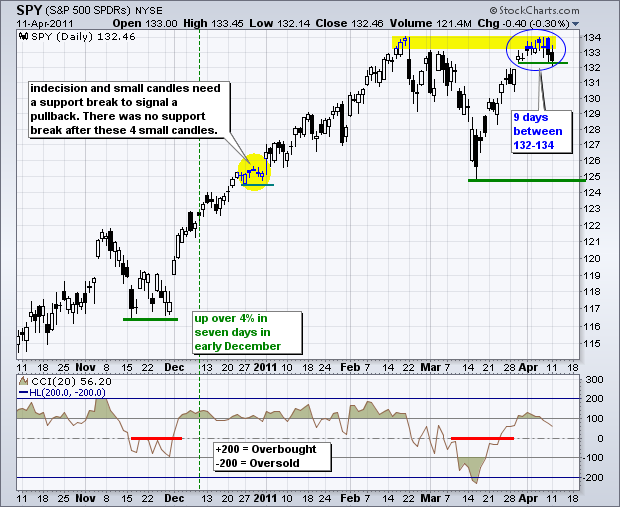There is not much change on the daily or 60-minute charts. The S&P 500 ETF (SPY) continues to battle resistance from the February high. Since moving above 132 on April 1st, the ETF stalled with five indecisive candlesticks and then two black candlesticks on Friday-Monday. Notice that a spinning top preceded Friday's candlestick. All the elements for a failure at resistance are in place – save one. SPY has yet to break minor support.

Short-term support is clear on the 60-minute chart. After gapping above 132 on April 1st, the ETF stalled with a trading range (132-134) the last six days. This range could be just a consolidation before a breakout and continuation higher. Also note that QQQ formed a falling flag over the last seven days and a break above 57.5 would be bullish. For SPY, a break above 134 would argue for a continuation higher. The gap holds the key. A move below 132 would fill the gap and argue for the much-anticipated pullback. RSI is trading at the low end of its bull range (35-90). A break below 35 would confirm a support break at 132.

Key Economic Reports/Events:
Wed - Apr 13 - 07:00 - MBA Mortgage Index
Wed - Apr 13 - 08:30 - Retail Sales
Wed - Apr 13 - 10:00 - Business Inventories
Wed - Apr 13 - 10:30 - Oil Inventories
Wed - Apr 13 - 14:00 - Fed Beige Book
Thu - Apr 14 - 08:30 - Jobless Claims
Thu - Apr 14 - 08:30 – Producer Price Index
Fri - Apr 15 - 08:30 – Consumer Price Index
Fri - Apr 15 - 08:30 - Empire Manufacturing Index
Fri - Apr 15 - 09:15 - Industrial Production
Fri - Apr 15 - 09:55 - Michigan Sentiment
Charts of Interest: Tuesday and Thursday in separate post.
-----------------------------------------------------------------------------
This commentary and charts-of-interest are designed to stimulate thinking. This analysis is not a recommendation to buy, sell, hold or sell short any security (stock ETF or otherwise). We all need to think for ourselves when it comes to trading our own accounts. First, it is the only way to really learn. Second, we are the only ones responsible for our decisions. Think of these charts as food for further analysis. Before making a trade, it is important to have a plan. Plan the trade and trade the plan. Among other things, this includes setting a trigger level, a target area and a stop-loss level. It is also important to plan for three possible price movements: advance, decline or sideways. Have a plan for all three scenarios BEFORE making the trade. Consider possible holding times. And finally, look at overall market conditions and sector/industry performance.






